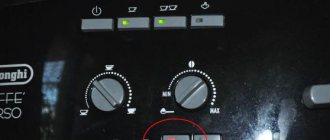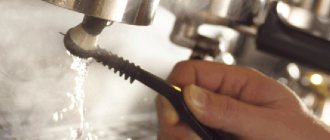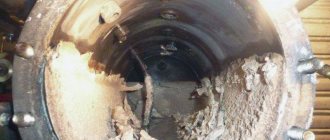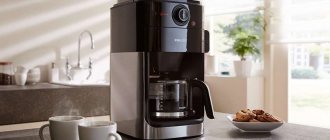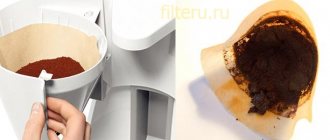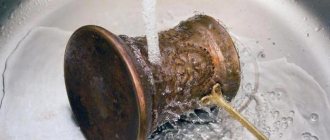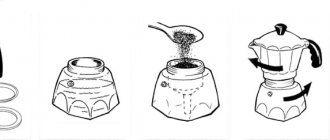With constant use of the coffee machine, limescale deposits form in it, leading to a deterioration in the taste of the finished drink and even to breakdown of the device itself. Simple folk methods will tell you how to descale a coffee maker at home. The best cleaning products are vinegar, citric acid, baking soda and salt. All you need to do is dilute the substances correctly and pour them into the device, after a few minutes all the deposits will disappear and the coffee maker will be like new.
When is it necessary to carry out procedures?
The period for cleaning the device directly depends on the degree of hardness of the water you use for preparing drinks.
As a rule, most modern devices have factory settings designed for the use of medium-hard liquids when operating the device. However, such cleaning periods can be called conditional: the rate of formation of mineral and lime deposits on the internal elements of the unit also depends on many other external factors that cannot be taken into account by the manufacturer.
Do you use your coffee machine often?
To know exactly when your machine needs descaling, first determine the hardness level of the water you use.
The easiest way to find out the value of the indicator is to use special test strips that come with the device:
- pour water into a small container;
- lower the test into the liquid for 1 second, remove it and place it on a horizontal surface;
- after 1 minute, evaluate the result: see how many squares have changed color and compare the data with the table.
| Number of elements that changed color | Water hardness indicator |
| 1 square | Very soft |
| 2 squares | Soft |
| 3 square | Tough |
| 4 square | Very tough |
In accordance with the result obtained, you can adjust the settings of your coffee machine by setting the required level of hardness.
If your device is not equipped with either special indicators signaling the need for cleaning or self-cleaning functions, you can conclude that the device is dirty based on the following signs:
- the sound of the machine running has become louder, the process of making coffee is accompanied by crackling and other extraneous noises;
- the drinks have an unpleasant, bitter taste, sediment remains at the bottom of the cup;
- the time to prepare a portion of coffee has increased;
- the drink comes out into the cup slowly, in a very thin stream.
Using water with high hardness for preparing drinks requires descaling the appliance at least 2 times a month.
Instructions for descaling different types of coffee makers
The process of cleaning a coffee machine depends on the type of unit and model.
Descaling a drip coffee maker
Cleaning a drip coffee maker at home is carried out in the following sequence:
- a tablet or a special liquid solution is placed in the water container in the coffee machine;
- you should fill them with water and wait until they are completely dissolved;
- the device starts up and goes through a full cycle for descaling in automatic devices or a full cycle in mechanical ones;
- the same process is repeated 3-4 times, only with clean water.
Enter data on the hardness of the water used in the coffee machine menu. The system will notify you about the need to descale the product.
After cleaning a drip coffee maker, it is better not to drink the first at least 3 cups of coffee - it is worth doing 3-4 rinses. But the process itself will allow you to enjoy your favorite aromatic drinks again.
To learn more about the features of caring for drip devices, you can study the instructions for the coffee maker for the home kitchen - Vitek VT-1506 BK.
If the coffee machine is a simple model, then we use the manual cleaning method.
Descaling carob, pod and capsule coffee makers
The operating principles of carob, capsule or pod coffee makers are practically the same, so they need to be cleaned identically.
It is recommended to clean the drain pan and cake strainer daily.
Decalcification stages:
- disconnect the electrical device from the network;
- remove spent coffee from the holder (horn);
- rinse the removable tank and fill it with the prepared solution;
- keep it in the tank for 15-20 minutes;
- empty the waste container;
- pour water from the pan;
- turn on and start the coffee maker;
- pass about half of the heated solution through the cappuccino maker nozzle;
- pass the rest through the capsule holder (empty horn) using the coffee preparation mode;
- perform 3-4 rinses with clean water.
You can familiarize yourself with the features of proper care for carob coffee makers using the example of the instructions for the popular, beloved espresso coffee machine Polaris PCM 1522E AdoreCappuccino.
Limescale is a serious problem, the occurrence of which can be avoided if cleaning procedures are carried out correctly.
Cleaning with Auto Clean Mode
In universal machines, the cleaning process starts automatically by pressing a button. To do this, you need to add the required product to the water tank and start the process.
Descaling your coffee machine helps prolong the life of your appliance.
How to clean a coffee maker filter
The filter is cleaned directly during the decalcification process. If the contamination is very severe, it must be soaked for 1-2 hours (depending on the degree of contamination) in the same solution.
The procedure for descaling the coffee machine should be carried out when the instrument has not been used, i.e. didn't heat up.
How to get rid of scale?
Water contains mineral salts: calcium, magnesium, phosphorus, chlorine. When coffee is brewed at a temperature of 88-95 degrees, they settle on the walls and parts of the coffee maker in the form of a sediment that does not dissolve.
Due to untimely cleaning of the device from carbon deposits and scale, a thick limescale crust appears on the inside. It forms faster from tap water.
Modern models are equipped with light indication. It notifies you that it is time for cleaning. If your device does not have such a function, monitor its condition and the taste of the drink.
Signs that scale has appeared:
- the outlet is clogged, so a thin stream of drink flows out of it;
- when the device is working, it makes a lot of noise and makes uncharacteristic sounds;
- the drink has an unpleasant aftertaste and a metallic smell;
- the device is leaking;
- a gray coating appeared in the cup.
Now let’s find out how to descale a coffee maker at home.
Auto cleanup
The automatic decalcification program should be carried out regularly, at least 2 times a month, if possible 1 time a week.
Procedure:
- remove any remaining coffee from the grinder and tray;
- fill the unit’s reservoir with hot water (to the maximum mark);
- place the selected cleaning agent in the liquid;
- turn on the automatic cleaning function, wait until the cycle completes;
- Fill the tank with clean water and turn on the coffee preparation mode. Repeat the rinsing procedure 2-3 more times;
- the machine is ready for further use.
Loading …
Preparations intended for descaling can be in liquid form or in tablets. Almost every coffee machine manufacturer offers its own products for cleaning units.
Using just such branded drugs will be the most effective and safe for your car model.
There are also universal preparations that can be used in coffee machines of any brand - Topper, Top House. All products should be prepared for the upcoming procedure in accordance with the instructions attached to them.
Cleaning tablets
All tablets for cleaning coffee machines are divided into two groups:
- for descaling;
- to remove deposits of coffee oils.
The drugs are not interchangeable: if you need to remove salt deposits from the hydraulic system, use only decalcifying agents; tablets for removing oil deposits will be useless in this case.
To carry out the procedure, dissolve 1 tablet in water (the exact proportions of the components are indicated on the product packaging), fill the unit’s reservoir with the resulting liquid, and turn on the coffee preparation mode.
Lemon acid
Citric acid is one of the most popular, effective and safe for human health improvised means used to remove scale from the surfaces of various household devices.
How to clean the coffee machine:
- disconnect the device from the power supply;
- remove the water container, clean it thoroughly with dishwashing detergent, and rinse under running water;
- make a solution of citric acid, at the rate of 15 g of acidic powder per 1 liter of water, fill the reservoir with liquid;
- turn on the device, set the coffee preparation mode;
- There should be enough cycles of operation of the unit so that the entire acid solution is completely consumed;
- Upon completion of cleaning, remove the container again, rinse it thoroughly, fill it with clean water and run 2-3 cycles of preparing the drink.
We suggest you read What to do if your jeans shrink after washing
Coffee machine descaling products
If you want to drink delicious coffee and extend the life of the device, it is important to get rid of limescale deposits in a timely manner. To do this, it is not necessary to take the device to a service center if the case is not completely advanced.
Manufacturers of coffee machines offer consumers a wide range of decalcification products, which are available in the form of liquids, powders and tablets. In addition to professional ones, folk methods of cleansing are popular.
Cleaning the body, tray, container and cappuccino maker
Simply wipe the body with a soft damp cloth, rinse the tray and container under the tap with a sponge. When cleaning the cappuccino maker, place the liquid collection tube in a container of water and turn on the hot steam supply.
Clean water flowing out of the tube means cleaning is complete.
Folk remedies
When spending the family budget economically, the question arises of how to properly and cost-effectively rinse an electric plastic coffee maker.
Since special means for cleaning limescale are often expensive, use folk recipes. There are two ways to descale your coffee maker using available products.
How to wash a capsule, geyser and other type model?
In devices of this type, instead of the usual filters present in other types of coffee machines, a plastic or metal horn is used - a holder, resembling a small sieve with a handle.
Ground beans or coffee pods are placed in a horn and fixed in the connector of the brewing unit. Water turns into a wonderful, aromatic drink, passing under high pressure through coffee pressed in a holder.
Carob machines can be equipped with a removable or built-in brewing unit.
Procedure for descaling a removable group:
- remove the block;
- rinse it thoroughly with running water, without adding chemicals;
- Leave the device outdoors until it is completely dry, then return it to its original location.
It is possible to remove scale in machines with a built-in cooking unit only by using special cleaning tablets.
The design of a geyser coffee machine is quite simple: the device consists of two compartments - a lower compartment for water and an upper part where ground coffee is poured. The top compartment has a metal filter that prevents sediment from getting into the finished drink.
Household appliances of this type are completely disassembled, making cleaning them easy. In addition to removing scale from both containers of the unit, be sure to wash the metal filter.
The tray and container for coffee in capsule machines can also be easily washed with running water with the addition of a small amount of chemically neutral detergents.
Cleaning of any other types of units (drip type, French press) follows a similar principle:
- provided that the tray and brewing unit are removable, the elements are washed every 7-14 days in running water;
- machines with non-removable functional units are cleaned using special tablets or liquids.
We clean with what we have at hand at home
Vinegar 9%
First, let's talk about how to clean a coffee maker with 9% vinegar. It contains alcohols, esters, food acids: malic, citric, which effectively dissolve scale.
Mix vinegar and water in a 1:2 ratio. Pour liquid into the water container and turn on the device. Wait for the water to boil and leave the coffee maker for 10-12 hours.
Then pour out the cleaning solution and rinse the device with warm water.
The next stage is running the liquid. Prepare 4-5 cups of coffee. Don't drink it - pour it out, otherwise you'll get poisoned.
If you don't rinse off the water, vinegar residue will settle on the parts. The drink will acquire an unpleasant taste and sour smell.
Lemon acid
Now about how to clean a coffee maker with citric acid. Pour 2 tbsp into a liter of water. l. facilities. The remaining steps are similar to the previous method.
Turn off the device when the water boils and leave for 2-3 hours.
Rinse the device parts under water. Pour clean water into the tank and boil it three times.
Then brew 3-4 cups of coffee to help draw out the liquid.
Lemon can deal with fresh limescale. Cut it into circles, put it in a tank and fill it with water. Boil the liquid and leave for half an hour.
Soda and salt
Dilute 2 tbsp. l. soda-salt mixture in 0.5 liters of warm water. Pour the solution into the tank and leave for 5 hours. There is no need to turn on the device.
Alkali reacts with limescale and destroys it.
Pour out the solution and rinse the device.
Coca Cola
To descale your coffee maker, use Coca-Cola. The drink contains phosphoric acid, which breaks down sediment.
Soda will not cope with a thick layer of plaque, but it will clean light stains.
Fill the reservoir to the brim with cola, turn on the device and boil the liquid.
Cleaning time – 2-3 hours.
Pour out the soda, rinse the device and wipe dry.
The product contains detergents, oxidizing agents and active oxygen. The tablets will cope with weak plaque and disinfect the device.
It is not recommended to regularly clean the device in this way - the tablets will not provide proper care.
Bleach is not suitable for cleaning coffee makers. The walls of the apparatus will be cleaned, but aggressive components will settle on them: sodium hypochlorite, sodium carboxymethylcellulose. They cannot be eliminated even if you wash the device parts with water.
Don't use soap. The product reacts with coffee oils, so the drink takes on a soapy taste.
Do not mix store-bought and folk cleaning products. Their components will react with each other, ruin the parts and disable the device.
We suggest you familiarize yourself with How to clean boiler heating elements from scale without disassembling them at home
Be sure to run water after using cleaning products. Brew at least 3 cups of coffee.
You should not drink coffee immediately after the procedure, as it contains impurities of cleaning products.
How to clean a coffee maker filter?
- First you need to clean the filter of debris.
- Then rinse the filter with warm water and place it in the coffee maker.
- The next step is to prepare the solution: mix one part vinegar with two parts water.
- Pour the solution into the container and turn on the coffee maker, as for making a cup of coffee.
- Leave the solution in the car for 15 minutes.
- Then remove the filter and drain the product.
- After the coffee maker has cooled, rinse the flask thoroughly with warm water.
- The washing process must be repeated, but with cold water. If the odor remains after rinsing, rinse the coffee maker again.
- Now you can make a cup of coffee.
Attention!
Under no circumstances should you use a solution containing soda. Such a solution can damage the filter.
Purchased funds
Liquid
Manufacturers of coffee makers and coffee machines produce liquid descaling products. They take into account the specific features of the models, are gentle on internal parts and eliminate plaque of any thickness.
The liquid that removes scale is based on acids. They react with salts and dissolve them.
Use the liquid immediately; it does not require additional additives. Pour it into a water container. The exact amount depends on the brand of coffee maker and is indicated in the instructions.
Rinse the water container before brewing coffee.
Disadvantages of the product: high cost from 300 to 1500 rubles. Branded drugs are only suitable for a specific model. Universal liquids are used for any device. Their cost is 20% lower.
Pills
Two types of tablets are available: for descaling and for cleaning coffee oils.
The basis of the product is active acid and sodium bicarbonate. Tablets are produced with an environmentally friendly composition from natural biodegradable substances.
Advantages: efficiency, compactness and availability in stores.
The instructions for the tablets indicate what types of coffee makers they are suitable for. The product completely cleans the device of plaque and does not harm internal parts.
Dissolve the tablet in water and pour the liquid into the reservoir. Afterwards, rinse it with water.
Cleaning the milk circuit of milk machines
The most capricious element of a coffee machine is the cappuccino maker. Milk or cream used to prepare the drink leaves a greasy residue on the walls of this part, which, when accumulated, can lead to clogging of the milk product supply hose.
In addition, such plaque is a favorable environment for the life of many pathogenic bacteria.
The main rule for caring for a cappuccino maker is to clean it regularly, at least once every 2-4 days.
System cleaning procedure:
- fill the milk container with clean water;
- turn on the machine, set the hot foam preparation mode;
- Repeat the cycle until clear liquid comes out of the cappuccino maker.
Rinse the steamer tube with running water after each milk emulsification.
After using chemical compounds, be sure to “run” the steamer several times, pouring clean water into the tank.
Clean mechanical devices (pannarello nozzle, manual cappuccino makers) after each use in clean water or with the addition of liquid dishwashing detergent.
Drip
Let's find out how to clean a drip coffee maker correctly.
Disconnect the device from the network. Then you need to remove the filter and rinse it with warm water. Add cleaning fluid to the water reservoir. Turn on the device for 10 minutes.
If there is plaque left on the walls, heat the liquid product to 40-50 degrees and leave it in the device for an hour. Then rinse the tank under water and wipe dry.
Now you know how to clean a drip coffee maker.
Let's figure out how to clean a carob coffee maker.
Shake out any remaining coffee from the cone and rinse under running water.
Mix water and vinegar in a 1:2 ratio. Place the strainer in the solution for half an hour. Then add 1 tsp. soda and wait another 10 minutes.
Rub the strainer with a toothbrush and rinse.
Wipe the cleaned parts of the carob coffee maker and install them in their place.
Pour the cleaning solution into the water reservoir: diluted tablets, vinegar or citric acid solution.
Release half of the liquid through the cappuccino maker in steam mode. Then turn on the coffee brewing mode and pass the solution through the horn.
Clean the cappuccino maker with a thin brush, brush or toothpick with gauze wrapped around it.
Do not wash the device completely under the tap. Otherwise, water will pour into hard-to-reach places, and when you turn on the coffee maker, a short circuit will occur.
The pod and capsule types work in a similar way to the carob model. The cleaning procedure is the same.
Geyserny
Remove the water tank, filter and ready-to-drink container and rinse with hot water.
Pour a cleaning solution at 40-50 degrees into the removable parts of the structure and leave for 20-30 minutes.
Dry the cleaned parts in disassembled form.
Wash the geyser after each use, then a thick layer of scale will not accumulate on the walls.
Do not rub the aluminum geyser coffee maker with a hard sponge. It will scratch the walls and the coffee will have a metallic taste.
Do not clean aluminum with preparations containing chlorine - they corrode the material.
Clean stainless steel with vinegar solution.
Pour vinegar solution into the device: 1 tbsp. l. for 1 liter of water. After half an hour, rinse with water.
We suggest you read What to do if the washing machine stops during washing? The washing machine stops during washing: reasons, troubleshooting methods
If you have washed the device and the plaque remains, repeat the procedure. This time add citric acid: 1 tbsp. l. for 1 liter of water.
Auto cleaning mode
Pour cleaning agent into the water tank. Press the auto clean button.
When the coffee maker turns off, rinse the water reservoir with water. Then repeat the cleaning to remove any remaining scale.
How do you clean your coffee maker?
If the article helped you, please rate it 5 stars and share the link with your friends.
Keeping the coffee maker clean
According to an ancient legend, there lived a shepherd Kaldim in Ethiopia, and around the end of the first century AD, he, driving goats through thickets of coffee trees, noticed (mankind was lucky that the shepherd was observant) that after the goats tasted the leaves from the coffee tree , they began to jump, jump and run merrily.
There was a monastery nearby, and the shepherd told its abbot about his observations. The monk decided to try the effect of the leaves on himself, and then began to brew a drink from this plant for his monastic brothers. Local residents adopted this custom from the monks. Thus began the “seizure of territories” by coffee. Today, its world dominance is undeniable.
Until the end of the nineteenth century, coffee was brewed in special vessels or turks invented by the Arabs, but technological progress was inevitable, and the first coffee machine was presented at the Paris Exhibition in 1855.
But the real breakthrough in the invention of coffee machines was made in Milan in 1901 by engineer Luigi Bezzera. Until now, modern coffee machines operate on the principle of using steam and water. In just a few seconds, a cup of coffee prepared attracts you with its aroma and delights you with a rich, strong taste.
Today, our kitchens use ancient Turks and multifunctional coffee machines, as well as French press, carob, geyser, drip and combination coffee makers. Having certain differences, they are united by one important point - easy care and the need for constant cleaning.
To prevent used coffee oils and scale from impairing the taste of the drink, dishes and equipment must be washed regularly. Then every cup of coffee will delight you with its unique taste.
- Let's start with the elders - the Turks. The method for cleaning it from coffee deposits is very simple. Just pour water into it, add one teaspoon of citric acid and put it on fire. After boiling for a couple of minutes, drain the water and wipe the Turk. You can rub the inner surface of the Turk with half a lemon. Then rub with a brush and rinse with water.
- Another easy way to make coffee is using a French press. Caring for it is as easy as the principle of its operation. After each brewing of the drink, the flask and press are washed with ordinary dishwashing detergent. If plaque does form over time, either citric acid or soda will help remove it.
- Coffee makers. Before cleaning the coffee maker, make sure it is disconnected from the power supply. Read the instructions for its use; perhaps there are some nuances for cleaning it. DO NOT wash the device by completely immersing it in water. Only the removable parts of the coffee maker can be washed under running water.
Stores today sell special care products for coffee makers and coffee machines. Scale and deposits from coffee oils can be easily removed from the walls of the coffee maker using special tablets, powders and liquids.
Before purchasing them, carefully read the instructions or consult the seller so that your money is not wasted and the cleaning product is suitable for your particular coffee maker model.
After using cleaning products, rinse all tanks of the coffee maker very well with running water. Detergents in coffee are not only tasteless, but also dangerous to health.
If using chemicals to wash dishes and household appliances is not for you, use safe and much cheaper products that are always available in the kitchen.
- Depending on the degree of contamination, the coffee maker can be washed with a vinegar solution in a ratio of one to two (if the plaque is not very strong), or in a ratio of one to one (if you don’t remember the last time you washed the device). Before pouring the solution into the water container, clear the filter of any remaining coffee grounds, rinse it and put it back in place. Then pour the vinegar solution into the coffee maker and turn it on to coffee brewing mode. Do not pour out the liquid immediately after finishing the coffee maker; wait fifteen to twenty minutes for the vinegar to work more effectively. Then drain the used solution and ALWAYS let the coffee maker run a full cycle again, but this time with clean water.
- An excellent alternative to vinegar is citric acid or lemon juice. Take a little citric acid on the tip of a knife and dissolve it in a glass of hot water; when the crystals have completely disappeared, add a glass of cold water. We clean the coffee maker with this solution using the same algorithm as with a vinegar solution.
- The most difficult option is a coffee machine. A more complex design requires more labor-intensive maintenance. (We do not consider a machine with a self-cleaning system).
Remember, if you use your coffee machine every day, you need to clean it every day.
- So, every day we clean all the elements of the coffee machine’s working group with a special brush. Wipe the holder, removable filters, all strainers and meshes, as well as the sealing rings with a sponge and soapy water. The soap solution should be thoroughly rinsed off with plenty of running water so that its smell does not affect the quality of the brewed coffee.
- After all internal parts have been wiped dry and put back in place, the outer surface of the device should be cleaned. To do this, use a soft cloth moistened with warm water.
- The steam tube is cleaned efficiently with a special brush. It is much more convenient to use than to invent some special devices.
- The steam wand can be thoroughly cleaned of scale and milk residues by soaking it in warm water for an hour.
- Once the tube is in place, take thirty seconds to blow the steam through it.
- Be sure to thoroughly clean the drain pan.
A so-called “blind” filter should be sold complete with the coffee machine. It received this name because it is attached to a holder instead of a regular filter, but has a blank, non-mesh surface. It is used to clean up a workgroup.
The cleaning procedure must be performed at least once a week:
- Having placed the blind filter, pour one teaspoon of a special cleaning agent into it, secure the holder in its place in the working group. Turn on the coffee machine as if you were brewing coffee. Then turn on the water supply for about twenty seconds.
- Water that cannot pass through the blind filter creates excess water pressure in the coffee brewing chamber. The reagent poured into the plug foams and, when the water is turned off, is discharged under pressure into the drain. At the same time, it dissolves and washes away all contaminants.
- The process is repeated several times until the discharged water is clean, free of reagent or coffee impurities.
- Then you should turn on the machine in idle mode to remove any remaining cleaning agent.
In the absence of special means, citric acid can be used as an exception rather than a rule (it should be noted that coffee machine manufacturers do not support this method).
Take one or two sachets of citric acid and pour it into the “blind” filter.
The further procedure is the same as with special means. Since many cleansers contain either citric acid directly or substances similar in composition, problems should not arise. And the last piece of advice, no matter what kind of coffee maker you purchase, before you start using it, wash all removable parts with clean water, and then turn on the coffee brewing process on idle. Then the taste of your coffee will not be spoiled by foreign odors.
Cleaning the filter
Most coffee making devices are equipped with filters, either disposable or reusable. If the filter is disposable, if it is dirty, simply replace it with a new one.
To clean a reusable element, in most cases, simply rinsing the part with warm water and some detergent is sufficient.
If this method does not help get rid of plaque, try the following method:
- make a solution of citric acid (5 tablespoons of the product per 1 liter of water);
- place the filter in the solution for an hour;
- After the specified time has elapsed, remove the part from the liquid, rinse with a brush in hot water, dry and place in its original place.
Cleaning other parts
Not only the above-mentioned functional elements of the coffee maker require regular cleaning: the device can operate normally only if all its components are clean.
Compartment for pulp
This compartment is designed to collect used coffee. If the settings are correctly set and the machine is in good working order, the cake comes out into the container in the form of a clearly formed tablet.
To clean the compartment, simply remove it (the device must be turned on), throw away the accumulated debris, and thoroughly rinse the element with warm water. Before installing it in its original place, dry the part thoroughly.
This situation will lead to clogging of the brewing unit and other internal components of the device.
Have you cleaned your coffee maker before?
Coffee grinder
The quality of the drink also depends on the condition of the coffee grinder: during the grinding process, particles of beans remain between the teeth of the millstones.
As a result of exposure to high temperatures, they stick together, gradually accumulating and forming a dense oily coating, which significantly distorts the taste of the prepared coffee.
Millstones are cleaned using special powders or tablets. Carry out the procedure after every 3-4 kg of ground grains.
Regardless of the type, all millstones are cleaned according to a similar principle:
- remove any remaining coffee from the hopper;
- turn on the grinding (until all remaining grain particles are completely removed), turn off the mode;
- pour 1 sachet of powder into the hopper or place a tablet in it;
- The cleaning compound must pass through the millstones. To do this, turn on the grinding again for 6 seconds;
- fill the container with beans, prepare 2-4 servings of coffee, pour them out.
The procedure is completed and you can enjoy a cup of aromatic drink.
How to remove the body, tray and container?
Wipe the machine body regularly with a slightly damp sponge, then with a dry, soft cloth - this will ensure that your device is completely free of dust and dirty stains.
It is extremely important to periodically drain the water accumulated in the pan - otherwise an unpleasant odor will appear in the device or mold will grow.
The tray can also be placed in the dishwasher and cleaned in this way (the processing temperature should not exceed 60 ⁰C). The tray can only be put back in place after it has been dried beforehand.
Some tips for use
A household appliance with an automatic cleaning function will notify you of the need to perform a procedure to remove oil deposits. All you have to do is simply put the cleaning tablet into the ground coffee hopper and start the unit’s operating cycle.
If you have an old-style device that does not have such a compartment, remove the brewing unit and place the tablet in the funnel into which the ground coffee is poured.
Care every day
Daily maintenance of your coffee machine includes the following:
- emptying and washing trays for liquid and coffee waste with running water;
- thoroughly rinsing the water tank;
- if you have a cappuccino maker, clean this element;
- wiping the device body with a damp, soft cloth.
Care every week
Weekly care of household appliances involves automatically cleaning the machine every 7 days using tablets or cleaning powders. Also, at least once a week, do not forget to remove and wash the brewing unit.
Proper and timely cleaning of your coffee machine will save you from the need for expensive repairs of the household appliance and will prevent your mood from being ruined in the morning by bitter, tasteless coffee.
Cleaning Recommendations
A few tips will help you avoid damage to your coffee system and descale it more effectively:
- completely dissolve powders and tablets in water before use, mix liquids with water;
- remove the filter from the tank to avoid damaging it with cleaning agents;
- Completely clean the machine by removing all parts every 300-400 cups of coffee.
Limescale is the main enemy of all coffee machines. The quality of the water used to make coffee will determine how often you clean the machine and its lifespan. To determine hardness, it is recommended to use special test strips.
Hard tap water is not suitable for drinking; it must be filtered or already purified water used. If the filter is built-in, it must be changed at least once every 3 months.
Decalcification of coffee makers without auto-cleaning function
Inexpensive models of coffee makers often do not have an automatic decalcification function.
A general algorithm has been developed for such models:
- Clean trays and filters by hand.
- Pour the descaling agent into a container of water.
- Place a container for drainage under the built-in cappuccino maker.
- Start cleaning, letting in the cleaning agent gradually.
- Rinse all removable parts under running water.
- Brew a couple of servings of coffee and be sure to pour them out.
Descaling coffee maker with automatic cleaning function
The presence of an automatic descaling function in the coffee machine greatly simplifies the maintenance of the device. After the indicator turns on, signaling the need for cleaning, all that remains is to pour water into the container, add a cleaning agent and start the process. Then periodically follow the instructions that appear on the display. This is usually a request to add water or restart cleaning one of the blocks.
Cleaning your drip coffee maker
Popular and inexpensive drip coffee makers are recommended to be descaled once a month. You can clean such a coffee maker from limescale deposits, like any other, using the general algorithm for machines with a self-cleaning function, if any, or according to the rules for cleaning a machine without a self-cleaning function. Both home and professional remedies are suitable for decalcification.
Cleaning the carob coffee maker
When deciding how to clean a carob coffee maker from limescale, pay special attention to the horn (holder) and tube. After passing the cleaning solution through the device, you need to unscrew the horn, disassemble it and thoroughly rinse all parts in running water with a sponge. General decalcification guidelines will also apply.
